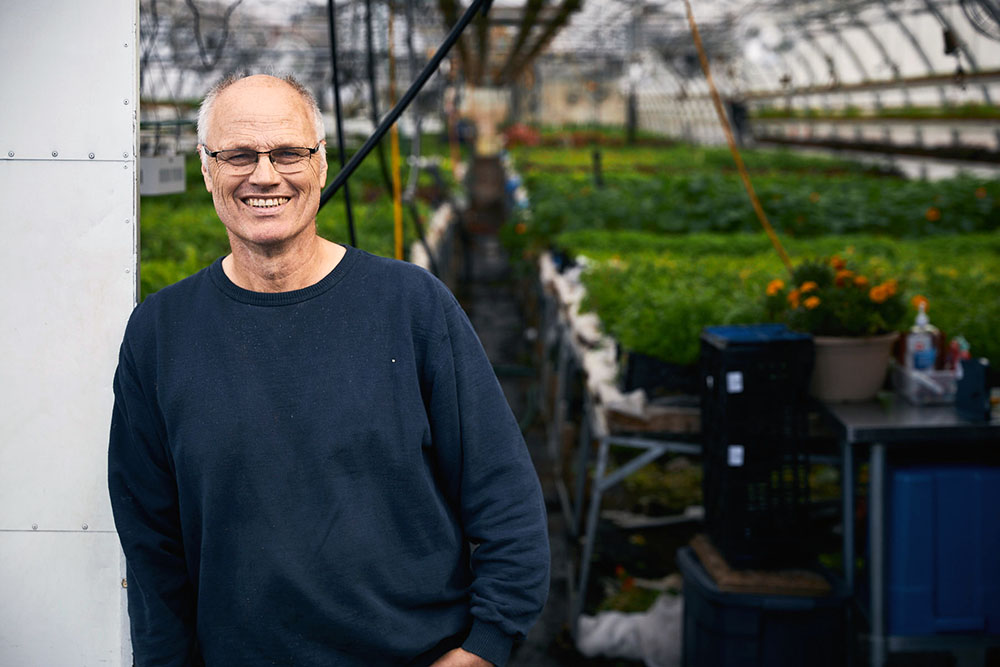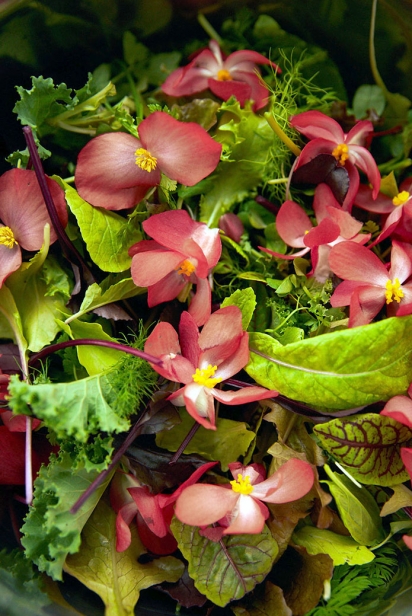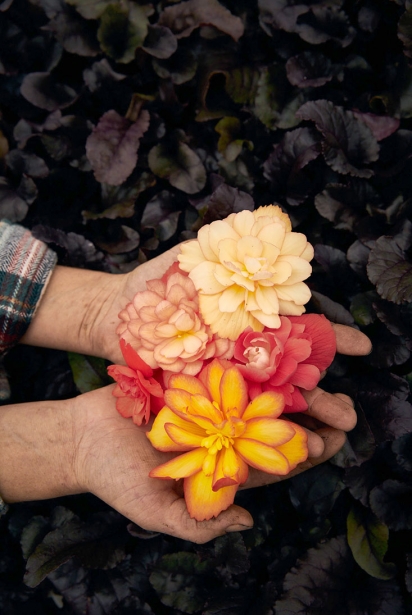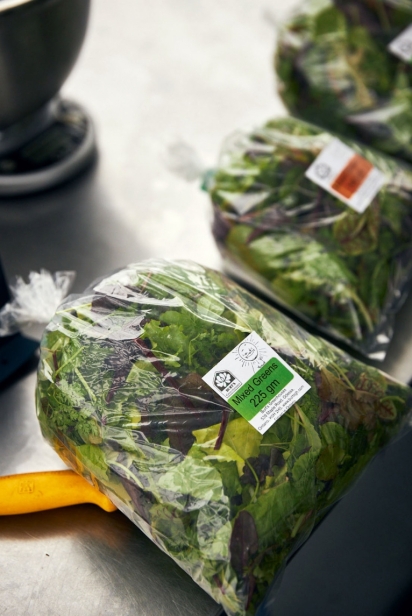Green All Winter Long
He’s led a good life, Brian Burt has. As a kind of amateur agronomist, inveterate tinkerer and lover of all things natural, he has, over nearly four decades, led a life of creativity and engaged stewardship of the hundreds of plants — flowers, vegetables and shrubs — that he grows at Burt’s Greenhouses in Odessa, 25 kilometres west of Kingston.
“My wife and I have had a pretty good life here,” he says, referring to his spouse and business partner Ruth Hayward. “Before I got into it, I really had no idea I’d wind up doing this. Perhaps we had more guts than brains — but I’m grateful for whatever sent us down this path.”
Burt’s Greenhouses is known not only for the quality of its plants, but also for the ingenuity with which Burt has optimized the growing environment in the 60,000 square feet of greenhouse space.
Burt’s Greenhouses has also won a number of awards for technical innovation. In 2007 and 2009, the company won the regional Premier’s Award for Agri-Food Innovation Excellence. The company was once voted the Agricultural Operation of the Year by business leaders in nearby Lennox and Addington. Burt has tapped the work of researchers at Queen’s University and the Royal Military College to develop ways of producing biochar, a charcoal-like substance that improves the health of soils. (Though the greenhouses did not, in the end, make extensive use of biochar, Burt’s fascination was indicative of his scientific bent of mind.)
“I studied biology at Queen’s — and I was doing a lot of research. Was it relevant to running a greenhouse? Well, let’s say it demonstrated my joy in immersing myself in problems and trying to solve them. And in 38 years, I’ve had lots of opportunities to indulge that.”
Back in 1981, the decision Burt and his wife made to start up a greenhouse operation was completely serendipitous. Burt’s father was retiring, and the couple had moved to Odessa to take over his dairy farm. Hayward wanted a market garden, and Burt, who’d had such a garden in his teens, was completely on board. They thought they might rent part of a nearby greenhouse to grow seedlings — but the owners, who were nearing their own retirement, suggested they rent the whole thing. “And that’s how it all started,” Burt says. “The opportunity was there and we took it. Maybe being 24 at the time explains the decision.”
Like her husband, Hayward has never looked back. “There are always hard points along the way — but we’ve had a good life here, with the kind of independence, physical work and outdoor life that suits my disposition.”
As a sometime farm boy and college grad with a technical bent, Burt was always in his element. He wanted to run the operation in way that was efficient, served the plants well and was respectful of the environment. He soon developed a reputation for being a first adopter, someone playing with the leading edge of innovation.
In 2001, he developed a method of pest control that used biological means instead of chemical ones. Essentially, he researched to find parasites and predators that would attack the pests that were threatening his plants. “There were books to consult, experts to speak with, and some wonderful websites, all fodder to feed my decision-making.”
Previously, to control aphids, he would have sprayed with soapy water, which was somewhat effective, but wasn’t exactly what the doctor would order for many plants. Using biological control, he found a parasite that destroyed aphid eggs — a far more efficient solution. Spraying would also have been his previous resort to control thrips (minute insects that were threatening various flowering plants) — but that wouldn’t kill any that were not on the exposed surface of flowers and would disperse many of them to other corners of the greenhouses. Through introducing little mites that preyed on thrips directly, he killed more of them and prevented dispersion.
His research helped him develop different biological controls against other pests.
To keep greenhouses within an ideal temperature range for the plants, Burt burns wood chips that provide heat as needed. In 2009, Burt won a regional Premier’s Award for Agri-Food Innovation Excellence for finding a way to control the airflow in the heating system so that emissions were greatly reduced, to the benefit of the environment. At the same time, he developed a way of feeding woodchips into the stoker that reduced power consumption.
“The main advantage of this heating system is environmental,” Burt says. “By burning wood instead of oil, we get a smaller carbon footprint. It’s not that we use so much less energy, but getting the energy from wood means we’re using a renewable source instead of oil. And we save a bit of money as well, probably about half of the cost of heating with oil.”
That same stoker allowed Burt to produce biochar, which, when mixed into soil, will store carbon and reduce carbon-dioxide levels in the atmosphere. He had hopes of using biochar in his operations, but he never managed to find a way of producing the quantity needed at a reasonable cost. Still, he thinks biochar will prove useful eventually — not to store carbon, but, in very small quantities, to trigger certain defences in plants against pests and disease.
Burt’s Greenhouses sells plants mainly at its own garden centre, “so our distribution is as far as people want to drive,” Burt says. Their vegetables, however, are more broadly available in southeastern Ontario outlets.
The staff at Burt’s Greenhouses is always eager to help would-be growers make decisions about how and what to grow. Burt himself addresses such questions on the company’s website, often to humorous effect. The heading of one of his posts asks, “What’s the difference between peas and beans?” With charming self-deprecation, he writes, “Each year, during the first few warm days of spring, we get people coming in looking for plants. People coming in offering us money is always a good thing (especially after the long hard winter!) but often the notion of appropriate plants for cold weather (and soil) vs. warm weather (and soil!) is not at the forefront of their thinking.”
He describes how similar peas and beans are — both legumes of similar size, producing pods with multiple seeds for harvest. “They must have the same requirements then, right? Well, of course you could see this coming, but the answer is no. Peas will readily germinate in cool soil so can be planted as soon as you can work your garden. They also don’t like the heat so if you don’t get them planted early enough, the heat of the summer will be very hard on them. Beans, on the other hand, require warm soil to germinate and if you plant them with the peas in April, [they] will simply rot before the soil warms up enough for them to germinate. Even if they do germinate, if we get any cold weather, they will be decidedly unhappy and if we get frost, it will kill them.”
The manner is intimate and unpretentious, the tone such that any listener becomes a student.
And he loves to teach. In one of his online notes to people who want to improve their luck with raising plants, Burt points out that too much water can be damaging. “If plants are underwatered or over-watered, the result is the same… root death. Once roots have been damaged, it takes time for the plant to repair and regrow new roots to support its top growth.” The solution, he notes, is “proper water management from the beginning.
"When you first establish plants, you want to water them very thoroughly, saturating the soil in their near vicinity. This will serve to wash soil into the voids around the roots leading to the best soil/root relationship. After that you want to allow the soil to dry out until just before the plants start to be stressed by lack of water.” As the root system expands during the season, you eventually hardly have to water at all, limiting the demand on aquifers and water-delivery systems.
Burt stresses that in life, one’s success is never solely due to one’s own efforts. “We’ve had many, many wonderful employees, my ‘right-hand people,’ as I say.” In summer, they have as many as 15, a number that falls to five in winter.
Hundreds of different plant species are grown at Burt’s Greenhouses. The list for potatoes alone is daunting — Adirondack Blue, Adirondack Red, Dark Red Chieftan, Goldrush, Irish Cobbler, Red Thumb, Superior, Yukon Gem, Yukon Gold, their particular traits all described on the website. Twenty species of begonias are listed more briefly. Three types of blueberry. Five types of cabbage. Twelve types of clematis. Seven types of cucumber. Ten types of delphinium. Five types of eggplant. Twenty-seven types of hosta. One wonders how 60,000 square feet of space can contain it all.
Even in winter, Burt’s Greenhouses have a very long product list that includes, among other items, beet greens, broccoli microgreens, buckwheat shoots, endive, green leaf sorrel, kale, leaf fennel, microgreen cilantro, mizuna, nasturtium leaves, pepper grass, red leaf sorrel and Swiss chard.
The greenhouses offer free delivery for orders of $75 and higher, with a $15 fee for smaller orders.
Burt’s concern for aquifers, fuel-burning efficiency and careful treatment of soil clearly suggest a concern for the environmental catastrophe that looms as we continue to burn fossil fuels. “It’s a very fraught subject,” Burt says. “It drives me to despair a bit to see a government that promotes a pipeline while it also imposes carbon taxes. Does the left hand know what the right one is doing? I sometimes wonder.” People in poverty will fare poorly over coming decades as global temperature warms; rich people, on the other hand, will have options. “If rising sea levels flood New York City, the poor will be challenged, but the rich will move to the Adirondacks.”
The only truly promising solution to climate change is, he believes, a drastic reduction in living standards. “But is that politically possible? You wouldn’t get elected prime minister by promising that. Our best hope, perhaps, is learning to mitigate and adapt to the changes that are probably coming.”
Burt and Hayward have three adult children, none of whom seem interested in taking over the business. “We home-schooled them here, and we absolutely loved having them around us — but we encouraged each to develop their individuality, and they did. While I think they have fond memories of growing up here, I don’t think they see taking over this business in their futures.” But that whole question is well in the future. For the time being, Burt and Hayward will continue living the life they stumbled upon so fortuitously 38 years ago — a fate which clearly, on all the evidence, ain’t so bad at all.
Burt’s Greenhouses
539 Maple Rd., Odessa, Ont.
burtsgh.com | 613.386.3426 | info@burtsgh.com
Open most days. Call to confirm.










